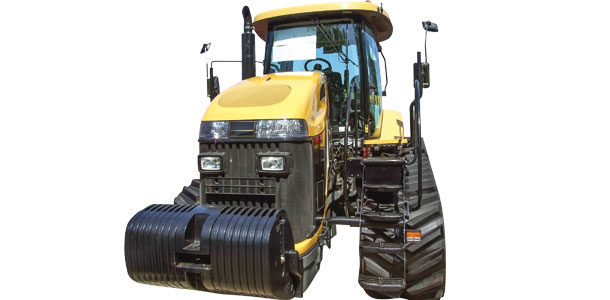A variety of equipment is used in a dairy operation – from tractors and skid steers to compact track loaders – yet they all have tire or tracks that need to be maintained. With replacement tracks and tires costing upward of $1,500, ensuring your tires and tracks will run as long as possible is imperative to reducing maintenance costs and downtime.
Of course, the longevity of your tires and tracks all depend on operating conditions and operator knowledge. For instance, dairy farm operators may not use their equipment for the same heavy-duty work as construction contractors based on their operating needs.
If your operating conditions are pretty mild and the equipment is mostly performing earthwork, you will likely see tire and track life in the 1,200- to 2,000-hour range. Luckily for most dairy farmers, dirt is the best surface when it comes to avoiding harsh wear and tear.
Tracks
Tracks are an important element that make up your equipment’s undercarriage. Undercarriage maintenance is extremely important because it’s the most costly part of any tracked machine.
In fact, the undercarriage represents roughly 20 percent of the initial cost of the equipment and 40 to 60 percent of its maintenance costs over the machine’s service life. For this reason, you should never put off repairing or replacing undercarriage components, including tracks.
To gauge wear on tracks, check for deflection within the track and on the machine, and check the tread strip or indicator for tread life. The key indicator that you are in need of new tracks is chunking (chunks of tracks that have been removed due to wear).
If new tracks are required, stick with a quality replacement track that is OEM-approved. Make sure the track pattern fits the primary operation or function of the machine. For example, you wouldn’t want to place an aggressive lug-designed track on golf course equipment. Let your local dealer know how the equipment is being used so they can help you make the correct determination.
A key factor in track upkeep is to monitor how much mud and dirt accumulates after each use. Try to clean your tracks and undercarriage often, as buildup can interfere with proper operation when you change the pitch and alter the component engagement, leading to faster wear.
Track tension also should be monitored in actual working conditions; if customers have to choose between tight and loose, they should opt for loose tension. They will not only reduce chain life when it is too tight but also put a strain on other components, like the front idler and carrier rollers. Routine monitoring also gives operators a chance to check for any loose or worn parts that may need to be replaced.
Tires
As is the case with tracks, tire purchases and maintenance can represent 15 to 20 percent of operating costs. And the main factor for how long your tires last is based on selecting the right tires for your operation. It’s important to share your applications with your local dealer so they can help you determine the tire with the ply rating and tread pattern right for you.
Another important aspect in tire maintenance is tire pressure. Always make sure tires are properly inflated. If the tire pressure is too low, it will flex more than it should and wear faster. Conversely, if pressure is too high, the tires can lose stability and traction.
The main factor for differentiating tires is the amount of rubber and other materials in the tire, tread and sidewalls. If you are looking at more heavy-duty applications, you might want to consider a tire that contains more rubber. More rubber means it will wear longer and resist punctures better.
Some tires are solid-wall rubber which makes them extremely rugged. They will never go flat because they don’t use air. Elliptical holes on the rim deliver the same smooth stable ride of a pneumatic tire and allow you to easily power through difficult conditions. They typically last at least three times as long as comparable pneumatic tires.
An add-on option for longer-lasting tires is adding tire liners that help protect tires from flats and are less expensive than foam-filled tires.
Operator tips
For both tires and tracks, operators play a key role in longevity. Always follow proper operating procedures and watch speeds. No matter what the quality of the tire, faster speeds can result in skidding. Other maneuvers to watch are sharp turns and rotations on hard surfaces.
When it comes to the lifespan of your tires and tracks, you have a great deal of control. Make sure you have the proper tires and tracks for your application, avoid extreme conditions and operate the equipment appropriately to enjoy long-lasting tires and tracks – and lower overall operating costs. PD
Kevin Lock is an industrial product marketing manager for tires, tracks and undercarriage with CNH.
PHOTO: Photo by ThinkStock.






